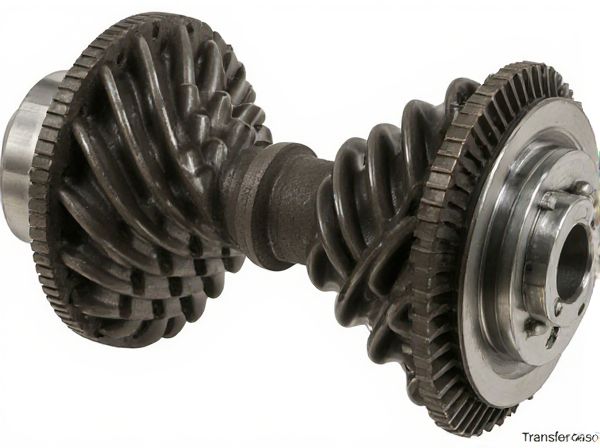
Photo illustration: Center Differential vs Transfer Case Differential
A center differential allows for smooth power distribution between the front and rear axles, improving traction on varied terrains. The transfer case differential, found in some four-wheel-drive vehicles, provides low-range gearing and can lock to ensure equal power delivery to both axles in challenging off-road conditions. Understanding the difference helps you choose the best drivetrain setup for your vehicle's performance needs.
Table of Comparison
| Feature | Center Differential | Transfer Case Differential |
|---|---|---|
| Function | Distributes torque between front and rear axles in AWD vehicles | Transfers power between front and rear driveshafts in 4WD vehicles |
| Vehicle Type | All-Wheel Drive (AWD) | Four-Wheel Drive (4WD) |
| Location | Between front and rear axles inside the drivetrain | Mounted behind the transmission, before axles |
| Operation | Allows differing wheel speeds for smooth cornering | Can lock or unlock axles for off-road traction |
| Complexity | More complex with active torque distribution options | Generally simpler, with manual or electronic locking |
| Usage | Better for on-road stability and traction | Designed for off-road and challenging terrain |
Introduction to Center Differential and Transfer Case Differential
Center differentials distribute torque between the front and rear axles, optimizing traction and handling in all-wheel-drive vehicles by allowing varying wheel speeds during turns. Transfer case differentials, often found in four-wheel-drive systems, manage power distribution between front and rear driveshafts, enabling mode selection like 2WD, 4WD high, and 4WD low for off-road capability. Understanding their roles is crucial for grasping drivetrain performance and vehicle stability across diverse driving conditions.
Key Functions of Center Differential
The center differential primarily manages torque distribution between the front and rear axles, ensuring optimal traction and handling on various road surfaces. It allows for differences in wheel speed during cornering, preventing driveline binding and reducing tire wear. Unlike a transfer case differential that mainly shifts power between 2WD and 4WD modes, the center differential continuously balances torque to maintain vehicle stability.
Key Functions of Transfer Case Differential
The transfer case differential plays a crucial role in distributing engine power between the front and rear axles, enabling optimal traction and stability in four-wheel and all-wheel drive vehicles. It allows for differences in rotational speed between axles during turns, preventing drivetrain binding and enhancing handling on various terrains. Unlike a center differential, which manages torque split primarily on the same plane, the transfer case differential integrates with the vehicle's drivetrain system to control torque distribution across different axles and drive modes.
Core Differences Between Center and Transfer Case Differentials
Center differentials distribute torque between the front and rear axles, allowing for smooth variation in wheel speed during cornering to maintain vehicle stability. Transfer case differentials manage power delivery between the left and right wheels of a single axle, often in four-wheel or all-wheel-drive systems to enhance traction on uneven terrains. The core difference lies in the center differential balancing torque front-to-rear, while the transfer case differential handles side-to-side torque distribution within a specific axle.
Role in All-Wheel Drive (AWD) Systems
The center differential in AWD systems manages torque distribution between the front and rear axles, allowing for smooth cornering and improving traction on varying road conditions. The transfer case differential primarily allocates power to both front and rear driveshafts, enabling power split and engaging different drive modes in part-time AWD setups. Effective coordination between center and transfer case differentials enhances vehicle stability, traction, and drivetrain efficiency across diverse driving environments.
Role in Four-Wheel Drive (4WD) Systems
The center differential in four-wheel drive (4WD) systems allows for the distribution of torque between the front and rear axles, enabling smooth operation on dry pavement by accommodating differences in wheel speed. The transfer case differential, often integrated within the transfer case, manages torque split and may include low-range gearing for off-road traction, but typically lacks the torque-biasing capabilities of a dedicated center differential. Understanding the distinct roles of both components is crucial for optimizing traction and vehicle handling in diverse driving conditions.
Advantages of Center Differential
A center differential allows torque to be distributed variably between the front and rear axles, enhancing traction and handling on diverse road conditions. It prevents drivetrain binding during turns by allowing the axles to rotate at different speeds, improving driving stability and reducing wear on components. The ability to balance power efficiently between axles makes the center differential advantageous for all-wheel-drive systems in both on-road and off-road environments.
Advantages of Transfer Case Differential
Transfer case differentials provide enhanced torque distribution across front and rear axles, improving traction and stability on varied terrains. They allow for seamless switching between two-wheel and four-wheel drive modes, optimizing fuel efficiency and drivetrain longevity. This system also reduces drivetrain binding during tight turns, preventing excessive wear and ensuring smoother off-road performance.
Common Applications and Vehicle Types
Center differentials are commonly found in all-wheel-drive (AWD) vehicles, such as passenger cars and crossover SUVs, where they distribute torque between the front and rear axles to improve traction and handling on varied road surfaces. Transfer case differentials are typical in four-wheel-drive (4WD) trucks and off-road vehicles, enabling drivers to switch between two-wheel and four-wheel drive modes while managing torque distribution for enhanced off-road performance. Both systems optimize power delivery based on vehicle type and application, with center differentials favoring on-road stability and transfer case differentials excelling in rugged, off-road conditions.
Choosing the Right System for Your Needs
Center differentials primarily distribute power between the front and rear axles, enhancing on-road traction and handling for all-wheel-drive vehicles, while transfer case differentials provide low-range gearing essential for off-road performance and heavy towing. Choosing the right system depends on your driving conditions: center differentials suit urban and highway driving with occasional light off-road use, whereas transfer case differentials excel in rugged terrain and demanding off-road environments. Consider vehicle application, terrain challenges, and desired drivetrain flexibility when selecting between these two differential types.
 caratoz.com
caratoz.com